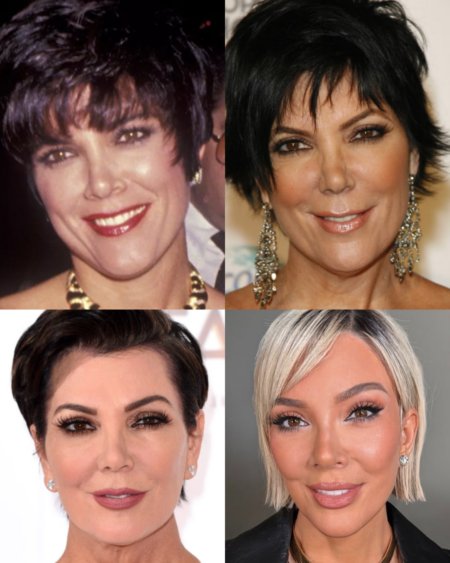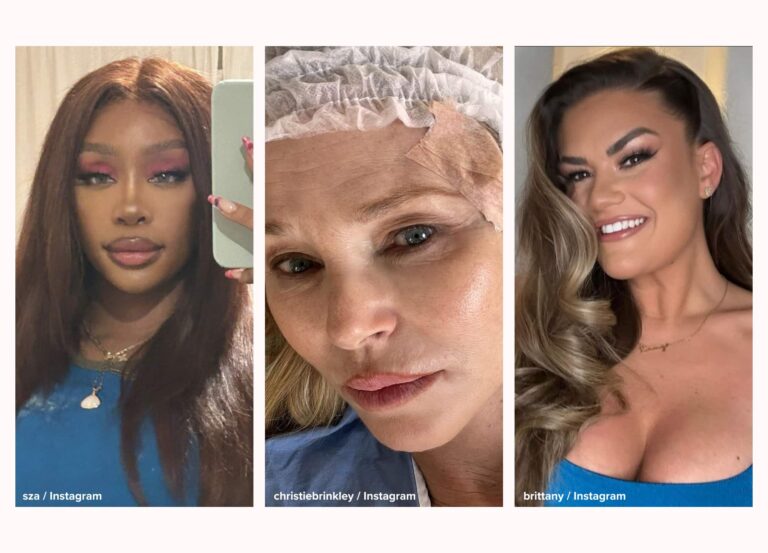Aesthetically speaking, this year will be remembered for how plastic surgery and treatments went mainstream. Celebrities and influencers embraced radical transparency like never before, sharing intimate details of the procedures they’ve had—or what they intend to do. GLP-1s created a surge of new patients, while regenerative treatments and groundbreaking minimally invasive techniques promised natural results with fewer risks.
At RealSelf, we’ll remember 2025 fondly as the year we turned pretty—and Charlie XCX made our dreams come true by telling Vanity Fair she looks to us for plastic surgery inspiration and info.
To fully wrap our heads around this aesthetics moment, we dug into RealSelf consumer data and asked some of our favorite plastic surgeons and dermatologists around the U.S. how the rise of aesthetics in pop culture influenced patient desires and procedure trends.
Here, we’re breaking down what’s been trending in the web’s largest aesthetics community, the shifts that surprised doctors this year, and the trends they say will dominate 2026.
First, some core stats and call-outs.
The most-viewed plastic surgery procedures
Alongside perennial favorites, the biggest surgical surprise in the top 5 was Motiva breast implants. Motiva won FDA approval in fall 2024 and has quickly won over U.S. patients and providers (more on that below).

On the noninvasive front, Botox once again drew the most attention on RealSelf, followed by social media darlings Sculptra fillers and CO2 laser treatments.

The fastest-growing procedures
Pageviews jumped most dramatically for Motiva implants and Endolift laser skin tightening, a fast favorite for sculpting the jawline and chin.
Another breakout: T-Shape 2, a relatively new noninvasive body contouring treatment.

The top aesthetic trends, according to doctors
Natural-looking enhancement was more popular than ever this year, as patients overwhelmingly asked for options that wouldn’t leave them looking overdone.
Dr. S. Alex Earle, a board-certified plastic surgeon in Miami, summed it up best: “2025 was the year of refinement over exaggeration. We saw a major shift toward more natural, balanced results: particularly BBL reductions, implant removals, and subtle fat transfers to the breasts. Patients are no longer chasing dramatic transformations. They’re asking for results that enhance what they already have.”
Dr. Stephen Greenberg, a board-certified plastic surgeon in Woodbury, NY, also saw “a clear shift from dramatic changes to more subtle, balanced enhancements. The goal is to maintain individuality and look like yourself but radiant and refreshed.”
In Scottsdale, AZ, board-certified plastic surgeon Dr. Bryan Gawley pointed to “the rise of refined naturalism—patients wanting to look refreshed, not ‘done.’ Patients are focused on achieving balance, harmony, proportion, and longevity.”
For many, the desire to look like a better version of themselves took on new meaning as they confronted sagging skin after major weight loss—which brings us to this year’s top trend.
1. A post-GLP-1 body contouring wave hit this year
Potent GLP-1 medications like semaglutide (Ozempic) and tirzepatide created a whole new category of aesthetic care that completely redefined the aesthetic landscape this year, according to most of the providers we surveyed.
As traffic to GLP-1 related content on RealSelf jumped 2080% year-on-year, patient demand skyrocketed for not just tummy tucks, thigh lifts, and arm lifts but full body lifts and facial rejuvenation.
Just outside Baltimore in Rockville, MD, board-certified plastic surgeon Dr. Adam Tattelbaum says his practice has been “seeing a huge uptick in skin tightening procedures after massive weight loss,” including “arm lifts, Fleur de lis tummy tucks, breast lifts, and more.” He attributes the surge to “the success of the GLP drugs,” and he notes that these patients “need more teaching and guidance about their options.”
In Seattle, board-certified plastic surgeon Dr. Shahram Salemy confirmed that “the biggest aesthetic trend of 2025 has been post-weight loss surgery. With the rise and accessibility of GLP-1 medications, more people are achieving significant weight loss and are now seeking surgical procedures to refine and complete their transformations.”
In Austin, TX, board-certified plastic surgeon Dr. Johnny Franco says “the fact that weight loss took over 10% of the aesthetic spend overnight” has transformed the industry. He also predicts “the weight loss revolution will have a long-term impact on skin health,” not necessarily for the better. “We will see mature issues [like significant laxity] in young patients, in numbers that we have never seen before.” Dr. Franco sees this as both challenging and exciting. “This is such a pivotal time in plastic surgery to literally sculpt the future of aesthetics.”
In Newport Beach, CA, board-certified facial plastic surgeon Dr. Ali Sajjadian says that the biggest change he saw in his practice this year was “the rise of Ozempic and Wegovy type weight-loss medications rapidly reshaping the cosmetic and medical aesthetics industry.” For providers like him with the expertise to restore a sense of balance and confidence to patients with newly deflated bodies and faces, “this has created a massive new customer base.”
Dr. Sajjadian has seen surging demand for noninvasive skin tightening and lifting treatments like RF microneedling, as well as facial fat grafting to selectively add volume.
In New York City, board-certified dermatological surgeon Dr. Ron Shelton reports similarly booming interest in Sofwave to tighten facial skin and smooth crepiness.
2. Smaller implants and “ballerina breast augmentation” got a boost
The trend toward more natural-looking breast augmentation (noted in last year’s trend report) also accelerated in 2025. Almost every plastic surgeon who weighed in said their patients favored natural fat grafting or smaller implants, for more freedom of movement with active lifestyles.
In her New York City practice, board-certified plastic surgeon Dr. Anna Steve says “the biggest aesthetic trend of 2025 was small volume implants. Patients are seeking subtle luxury with natural, and often undetectable breast augmentation results.”
In Seattle, Dr. Salemy has also seen “a noticeable shift in breast enhancement trends. Patients today are opting for smaller implant sizes than in years past. Several years ago, the most common implant sizes in our practice ranged from 300–400cc, whereas now, the average range is 185–285cc. Women are increasingly seeking a natural, proportionate enhancement.”
Dr. Urmen Desai, a board-certified plastic surgeon in Beverly Hills, also attests that “in 2025, the aesthetic of breast augmentation shifted toward a subtler, more natural silhouette—an evolution embodied by the rising preference for smaller-size Motiva implants placed in the sub-fascial plane.” He sees patients prioritizing “proportion and comfort—choosing implants that gently complement rather than dominate the frame.”
His patients favor Motiva, “with their advanced silicone gel technology and micron-textured surface designed to reduce the risk of capsular contracture,” a hard, painful capsule of scar tissue that can form around implants. He explains that positioning the implant just under the fascia (not under the muscle) allows the surgeon to “preserve muscular anatomy, reduce animation deformity [unwanted contortion of the breast during movement] and achieve a smoother transition from chest wall to breast mound—enhancing mobility and lifestyle adaptability. The smaller size and sub-fascial placement reflect a broader wellness trend: aesthetic enhancements that feel personal, functional and enduring rather than overt or high-impact.”
Dr. Steve is also a fan of Motiva implants, which she credits with broadening the appeal of breast augmentation procedures. “With capsular contracture rates less than one percent and implants that look and behave more like breast tissue, we are seeing more women consider breast enhancement than ever before.”
In Seattle, board-certified plastic surgeon Dr. Suzette Miranda sees the “ballerina breast” as “another way of stating a more natural, well balanced augmentation. Patients are increasingly interested in selecting implants that fit their unique anatomy, natural shape and lifestyle.”
Dr. Greenberg also reports seeing more patients from 10 to 20 years ago who “want their implants exchanged for either smaller implants or no implants.” He attributes this “yoga boobs” trend to a larger cultural shift toward “a healthier and more active lifestyle.”
3. Facial rejuvenation and regenerative treatments leveled up
Patients gravitated toward more minimally invasive, “undetectable” options for facelifts, skin tightening and regeneration, and facial balancing.
Dr. Paul Nassif, a board-certified facial plastic surgeon in Beverly Hills, saw a rise in younger patients this year. He says they tend to take a more holistic approach to aesthetic enhancement “through smaller, carefully planned procedures that can help slow the progression of aging and prevent wrinkles from forming. Microfat grafting is becoming very popular among my younger patients, and a great alternative to filler, especially as many are trying to seek more natural alternatives.”
For his more mature patients, he often recommends a technique for “deep plane facelifts, neck lifts, brow or lip lifts that involves the creation of a delicate external ‘net’ like pattern with surgical sutures to provide gentle compressions that help to reduce bruising or hematomas. There is less swelling with this method and overall recovery is faster.”
Dr. Nassif emphasized the importance of comprehensive care “that blends aesthetics with wellness,” and says his practice offers “a range of ancillary treatments including red light therapy, IV therapy, hyperbaric oxygen therapy, CO₂ masks, and lymphatic massage—all of which help the body recover faster and optimize outcomes. The goal is to create a complete regimen that doesn’t end with the procedure itself.”
In Dr. Greenberg’s practice, he saw an influx of “younger patients for lower face, neck, and jawline rejuvenation.” He points out that “these areas show aging earlier and can be addressed less invasively.” Specifically for this younger demographic, he offers a “micro-mini facelift,” often “combined with med spa technology such as radio frequency, microneedling and ultrasound” to increase collagen production and improve skin quality.
Dr. Kevin Tehrani, a board-certified plastic surgeon in Great Neck, NY, fielded more patient requests for “procedures like Contour Lifts, endoscopic facelifts, and noninvasive skin tightening” that “deliver visible results without telltale downtime.”
While some patients still request “a volume of filler which would create an unnatural appearance,” Dr. Shelton reported that “the great majority of patients I see now who are entering the filler market express their concern that they do not want to look alien.” He often focuses on replacing lost volume “so they can recognize themselves better” and favors Evolysse, a hyaluronic acid-based filler that has “produced more natural results in many of my patients.”
Dr. Sajjadian’s patients asked for “natural, undetectable results, such as microtox (baby Botox) and undetectable dermal fillers that prioritize facial balance and harmony.” He also reports a “major rise in treatments that work with the body, like Platelet-Rich Fibrin (PRP/PRF) and other bio-stimulators.”
Dr. Gawley’s practice “experienced growing demand for small-volume fat grafting, regenerative biologics like PRF and exosomes, and subtle surgical lifts performed earlier in life.” He expressed surprise at “how quickly patients are embracing surgical correction earlier, rather than chasing diminishing returns with non-surgical options.” In his eyes, it’s “refreshing to see this evolution reflecting a more mature aesthetic mindset: today’s patient values timeless, healthy beauty over trend-driven enhancement.”
Especially for patients left with sagging skin after weight loss, some artful volumizing is often the goal. Dr. Franco praised alloClae, the first body filler, as a type of “fat in a can” that “has literally filled an unmet need, creating opportunities [to treat] Ozempic breasts and butts when patients didn’t have any options previously.”
“AlloClae has been a standout” in Dr. Earle’s practice. He explains that it “uses processed donor fat tissue to restore volume and improve skin quality, without needing liposuction or synthetic fillers.” In his eyes, “it perfectly matches where aesthetics is heading: natural, long-lasting, and regenerative.”
“Demand for off-the-shelf donated fat grafting injections like alloClae and Renuva” was also surprisingly strong among Dr. Tehrani’s patients.
4. Rib remodeling went more mainstream
Rib contouring went from niche to maybe-the-next-big-thing this year, as surgeons redefined the waistline with precision.
Jolene Edgar, former RealSelf contributor and founder of the cult-favorite Substack Aesthetics Unfiltered, covered the trend in Allure last April. She stressed the importance of seeing a board-certified plastic surgeon who’s an absolute expert, to mitigate risks like pneumothorax, a compromised lung (rare, but possible).
Several surgeons we surveyed saw it gain momentum this year.
Dr. Earle in Miami pointed out that the procedure has long been popular in South America for “creating feminine curves that look elegant and natural.”
Dr. Franco said what was considered “a passing fad” just a year ago is growing, changing perceptions about the limits of body contouring. “Now we can enhance the entire frame of a person, to create curves and a shape where in the past the only option was to enhance the buttock or hips—to make things larger. Now patients can keep their pilates bodies—sleek, fit and contoured.”
The most influential social media moments of 2025
For Dr. Earle and others, the most surprising trend this year was the number of “public figures and celebrities openly talking about their plastic surgery.” He sees this “huge cultural shift” as “a really positive thing” for patients. “When people can have open conversations about their procedures, it removes stigma, encourages education, and helps patients make safer, more informed choices that lead to better outcomes.”
This was a recurring theme among doctors, including Dr. Desai, who points to “a significant uptick in transparency.” He sees “procedures that were once quietly done behind closed doors are now being openly discussed with details like implant sizes, techniques and recovery experiences shared in public forums. This transparency benefits patients by enhancing realistic expectations, fostering informed consent and helping prospective patients evaluate options with greater clarity.”
Dr. Franco calls this “transparency trend one of the most influential movements of 2025. When it comes to patient discussions and interactions, transparency changed everything.” He credits this shift with “helping patients and plastic surgeons start having more meaningful, honest conversations. I think it was eye-opening for a lot of patients to realize just how many procedures many of their favorite influencers and celebrity crushes have actually had over the years.” Some celebs still credit a good skincare routine and healthy diet, “when in reality, it was a combination of treatments, surgeries, and maintenance. This new level of openness helped patients see that achieving those results is a process, not a quick fix.”
Beyond the impact of individual celebs, Dr. Greenberg pointed to the Bezos-Sánchez wedding as “an impactful affair where the guests weren’t just rich, they were refreshed. From snatched jawlines to poreless skin, the event looked like a masterclass in luxury plastic surgery. Guests were glowing, sculpted, and ageless. We’re talking laser-tightened skin, airbrushed under eyes, ultra-discreet facelifts, refined noses and refreshed necks. Today’s luxury aesthetic trends are shifting toward invisible, high-performance tweaks” that can leave a face looking “untouched, but totally transformed.”
These were the biggest social media moments of the year in the world of aesthetics.
Kylie Jenner revealed her breast augmentation deets
When fan Rachel Leary asked Kylie in a TikTok to “help a girl out” with details how she got “the most perfect natural looking boob job ever,” the reigning queen of transparency responded with her exact order to Beverly Hills plastic surgeon Dr. Garth Fisher: “445 cc, moderate profile, half under the muscle!!!!! Silicone!!! Hope this helps lol.”

According to RealSelf doctors, her words had a ripple effect they’re still seeing in their practices, making this absolutely the most influential celeb moment of the year.
Dr. Earle also praised Kylie, noting “that level of detail and honesty was something we hadn’t seen before.”
Dr. Steve said it “helped spark the beginning of what industry experts are calling the ‘transparency era.’ Her transparency inspired many other women to generously share their story. The media response by plastic surgeons also helped spread knowledge about implant size selection.”
While she cautions that “Using another woman’s ‘implant stats’ to achieve a similar look is likely to lead to unsatisfactory results, using another woman’s aesthetic to communicate your aesthetic goals is a great way to provide a visual guide for your aesthetic outcomes.”
Dr. Miranda found it “refreshing to see the dialogue around breast augmentation become more open and so many patients felt comfortable talking about it. However, it also led to a wave of requests for her exact implant size, which doesn’t always translate well across different body types…. The best results come from customizing the procedure to the individual’s anatomy and proportions, not replicating someone else’s look.”
Dr. Desai saw Kylie’s openness spark a broader cultural shift, pointing out that “patients are increasingly valuing honesty and education over secrecy, seeking to understand not just their results but the technical details behind them. This new era of openness encourages realistic expectations and informed decision-making, helping to demystify procedures that were once treated as taboo.”
Kris Jenner’s facelift set a new bar
Fans noticed a difference in May, when an ultra-refreshed Kris partied with then-bachelorette Lauren Sánchez and friends in Paris. She soon confirmed on social media that she’d had her second facelift (more than a decade after her first), with Page Six revealing her surgeon as Dr. Steven Levine in New York City.

Jenner told Vogue Arabia she did this facelift “because I want to be the best version of myself, and that makes me happy.”
When she turned 70 this November, her Bond-themed birthday party favors included poker chips with images of her face, and Dr. Levine was at her side to celebrate.
Dr. Dilip Madnani, a board-certified facial plastic surgeon in New York City, credits Kris Jenner’s results with driving “incredible” growth in facelift requests this year.
Dr. Shelton says it has “made the public more at ease to discuss their own cosmetic procedures … with their families and friends. This gives them confidence to finally pursue their interest in improving what bothers them with less worry about what others may think,” and in less isolation.
These celebs and influencers inspired our Instagram followers or sparked speculation:
- Khloé Kardashian’s stunning look at the Bezos wedding, and her transparency around all the procedures she’s had over the years, including a nose job, laser hair removal, Botox, Sculptra, Sofwave, filler (“but not any over the last few years), collagen baby threads, salmon sperm facials, peptides, vitamins, and daily skin care
- Demi Moore looking radiant at the Oscars
- Anne Hathaway’s Met Gala glow-up
- Bradley Cooper’s new look (possibly post-blepharoplasty)
- TikTok user @michellewood165, who shared her incredible Guadalajara facelift journey and revealed that she chose her doctor by reading RealSelf reviews
- Serena Williams’s revelation that she lost 31 pounds taking the GLP-1 Zepbound after the birth of her second daughter
- Jennifer Lawrence’s frank interview with The New Yorker, where she revealed that she gets Botox and fully intends to have both breast augmentation (soon) and a facelift.

Top aesthetics predictions for 2026
Treatments will get smarter, subtler, and more science-driven than ever in the coming year, according to our doctors. Patient expectations will only grow for treatments that work with their biology and technologies that make every outcome more predictable, for natural results with less downtime.
Minimally invasive techniques are leveling up, regenerative medicine is entering its breakout era, and GLP-1–driven weight loss is reshaping what patients need from head to waistline.
The future of beauty is precision-built, anatomically respectful, and powered by cutting-edge tech.
These trends will define 2026.
1. Pre-weight loss “fat banking” will become more widely available
One “fat enhancement product” Dr. Franco is excited to see coming to the market is strategic fat freezing, which he says will become a more common option for patients next year.
“GLP-1 patients can have liposuction prior to their weight loss journey, bank their fat, and when they reach their goal weight they can treat their Ozempic butt/Breast/Face with their own fat” to contour their new body. “There are even research projects underway exploring how to expand the amount of fat a patient has and create moldable, stable fat implants—essentially designing implants made entirely from your own tissue.”
Those who don’t think ahead to bank fat will also have more options, according to Dr. Franco. “LipoDerma has just entered the market—a fat product designed for low-volume facial treatments. Then in 2026, we’ll see dermaClae, the sister product to alloClae, specifically designed for the face. All of this points to a huge trend toward natural alternatives [to synthetic fillers].”
2. Preservé by Motiva will define the natural breast era
Breast trends will continue moving toward smaller volumes, softer silhouettes, and anatomy-preserving techniques, especially as Preservé by Motiva launches in the U.S.
Motiva recently started training plastic surgeons on Preservé, a less invasive breast augmentation technique designed to preserve natural structures and sensation. Dr. Steve reports that currently, only 36 U.S. surgeons have been trained on the Preservé technique. But “it will undergo commercial launch in the US in 2026, making it more widely available to patients.”
Preservé is “a revolutionary change in concept” based on “utilizing your anatomy to support, sustain and shape your breasts,” according to Dr. Franco. As he explains it, “The technique utilizes modern technology like ultrasound to hydro-dissect the natural space above the muscle and below the breast gland.” A smaller implant “is confined by the ligaments of the breast that are pushed into a nesting effect, to support and shape the breast.” He foresees “it will create a movement … to make other procedures less invasive and aligned to the body’s natural anatomy.”
Dr. Desai also welcomes Preservé, which “represents a forward-thinking shift in aesthetic breast surgery, designed to preserve rather than disrupt the natural breast anatomy. Unlike traditional augmentations that often detach muscles or sever ligaments, Preservé uses specialized tools (such as a channel-separator and inflatable balloon) to gently create the implant pocket in front of the pectoralis muscle, thereby preserving muscle, ligaments and nerve-vascular structures. The approach is minimally invasive—typically involving a small 2–2.5 cm incision in the inframammary fold and often performed under local anesthesia or light sedation without the need for general anesthesia; yielding shorter downtime, less swelling and more rapid recovery.”
This technique is especially suited for patients who want natural-looking results, but there are other benefits: long-term implant stability and less scar tissue. In his eyes, “Preservé stands out as an elegant marriage of technology, anatomy-respecting surgery and aesthetic finesse.”
Dr. Desai is looking forward to future FDA approval of the MIA™ (Minimally Invasive Augmentation) system from Motiva, which he says “represents a new category in breast enhancement via an armpit incision, designed for women seeking a subtle, faster-recovery option.” Another benefit: it’s often performed under sedation or local anesthesia, not full general anesthesia.
MIA augmentation involves Ergonomix2 Diamond implants, which Dr. Franco says have been “designed to allow the same amount of projection and shape to the breast but have 30% less volume so the implants weigh less” and can pass through a smaller incision.
3. Post-weight-loss body contouring procedures will continue to rise
Doctors also predict the demand from GLP-1 patients will keep climbing in 2026, as the next wave of weight loss patients grapples with unwanted aesthetic side effects.
“We’ll continue to see a rise in post weight loss surgeries such as tummy tucks, breast lifts, body lifts, and facelifts,” says Dr. Salemy.
4. The regenerative revolution will accelerate
2026 will be a landmark year for regenerative aesthetics. Regeneration is no longer a buzzword: it’s the new backbone of aesthetic medicine.
Dr. Franco says that while “regenerative has been a hot topic for a few years now, the difference today is that the science is finally catching up to the hype.” Potent peptides and other treatments that harness the body’s innate ability to heal itself are part of what he calls a “wellness wave” leading to a “regenerative revolution,” focused on health and longevity.
He’s not alone: Dr. Shelton is expecting new treatments with “AI/quantum computing-generated molecular peptides with liposomal delivery into the dermis, signaling many other deeper stem cells and pluripotential cells to rejuvenate our skin. Although we may not see this next year, this computer-assisted science is coming more quickly than most of us would imagine.”
He also has high hopes for polydeoxyribonucleotide (PDRN) treatments, like the social media-favorite salmon sperm facial. “It’s not yet FDA-approved to be either injected or applied with laser or microneedling to deliver the chemicals into the dermis, but the scientific literature is rather convincing of its beneficial properties.”
On the other hand, several of the doctors we spoke to emphasize the need to temper enthusiasm for treatment innovations with rigorous, evidence-based clinical trials and regulatory approvals. Even Dr. Gawley, who says he’s “excited about the next wave of biologic and regenerative technologies already available internationally—particularly cell-enriched fat grafting, scaffold-based implants, and advanced exosome formulations” points out that while “treatments using exosomes, growth factors, or stem-cell derivatives show promise, but patient education and scientific rigor must keep pace with marketing.”
5. Patients will demand less invasive procedures
On the surgical side, patients will increasingly expect nonincisional and minimally invasive options for facelifts, neck lifts, and body surgeries. Dr. Tehrani predicts “continued demand and expectation of dramatic nonincisional facelift results in younger patients.”
Younger patients in particular want results with tiny incisions (or none at all). Dr. Madnani expects to see younger facelift patients in 2026, as well as more patients for “prejuvenation” treatments like exosomes and stem cells.
Dr. Sajjadian also expects even more focus on holistic regeneration, “an inside-out approach focusing on overall cellular health, collagen production, and tissue quality” for subtle, long-term results.” He sees more patients “seeking to look like a younger, more vital version of themselves” who will be increasingly open to “integrating surgical results with non-surgical texture improvement,” like “deep plane facelift followed by RF microneedling and biostimulation.”
6. AI will reshape aesthetics
AI isn’t just influencing marketing, it’s shaping outcomes. From treatment planning and results-prediction modeling to enhanced patient-provider communication, AI is quickly becoming essential to how modern practices operate.
Dr. Franco predicts that “AI will continue to change the entire epicenter of aesthetics. It will change how plastic surgeons run their practice, how they market the practice, how patients search for and find their new aesthetic provider. It will make treatments more predictable” and “help patients and providers better communicate and optimize outcomes.”
Emerging innovations, including AI-designed peptides and molecular regeneration tech, hint at a future where personalization reaches an entirely new level.
6. Rib remodeling will continue to surge
Most patients will still want to avoid overly dramatic curves, doctors predict rib remodeling will continue to gain popularity next year.
Unlike more extreme rib removal procedures of the past, this body contouring surgery “allows us to sculpt and refine the waistline safely and with precision,” says Dr. Earle. “It’s not for a drastic change, but to create natural, feminine definition that complements the patient’s anatomy.”
This report is based on consumer search data on RealSelf.com from January 1 through October 31, 2025. Find more details about patient-reported average costs and Worth It Ratings on RealSelf or email questions to contactus@realself.com.









